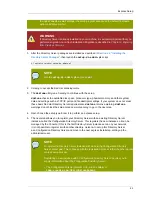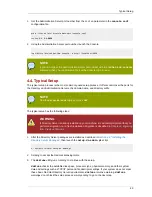
Chapter 4. Setting up Red Hat Directory Server on HP-UX 11i
40
NOTE
Directory Server 8.0 requires JRE version 1.5.0.
Download the JRE from
http://www.hp.com/products1/unix/java/
, and install it according to the HP
Java instructions.
After installing the JRE, install the Directory Server packages, as described in
Section 4.2, “Installing
the Directory Server Packages”
.
4.2. Installing the Directory Server Packages
The Directory Server packages for HP-UX 11i are included in an SD package which can be
downloaded from HP.
For complete instructions on installing the Red Hat Directory Server packages on HP-UX, see the HP-
specific release notes at
http://docs.hp.com/en/internet.html#Netscape%20Directory%20Server/Red
%20Hat%20Directory%20Server
. After the Directory Server packages are installed, run the
setup
program to set up and configure the default Directory Server instance and the Administration Server.
/opt/dirsrv/sbin/setup-ds-admin.pl
Accept the initial screens for licensing and
dsktune
output, then select the setup type, and proceed
with configuring the new Directory Server instance.
•
Section 4.3, “Express Setup”
•
Section 4.4, “Typical Setup”
•
Section 4.5, “Custom Setup”
NOTE
Directory Server version 8.0 conforms to the Filesystem Hierarchy Standards. This
means that the directories and files are in different locations than previous versions. For
more information on FHS, see the
http://www.pathname.com/fhs/
homepage. For a table
showing the new file locations, see
Section 7.1, “Directory Server File Locations”
.
4.3. Express Setup
Use express installation if you are installing Directory Server for an evaluation or trial. Because
express installation does not offer the choice of selecting the Directory Server server port number
or the directory suffix, among other settings, Red Hat recommends not using it for production
deployments.
NOTE
The setup program gets the host information from the
/etc/resolv.conf
file. If there
are aliases in the
/etc/hosts
file, such as
ldap.example.com
, that do not match
















































